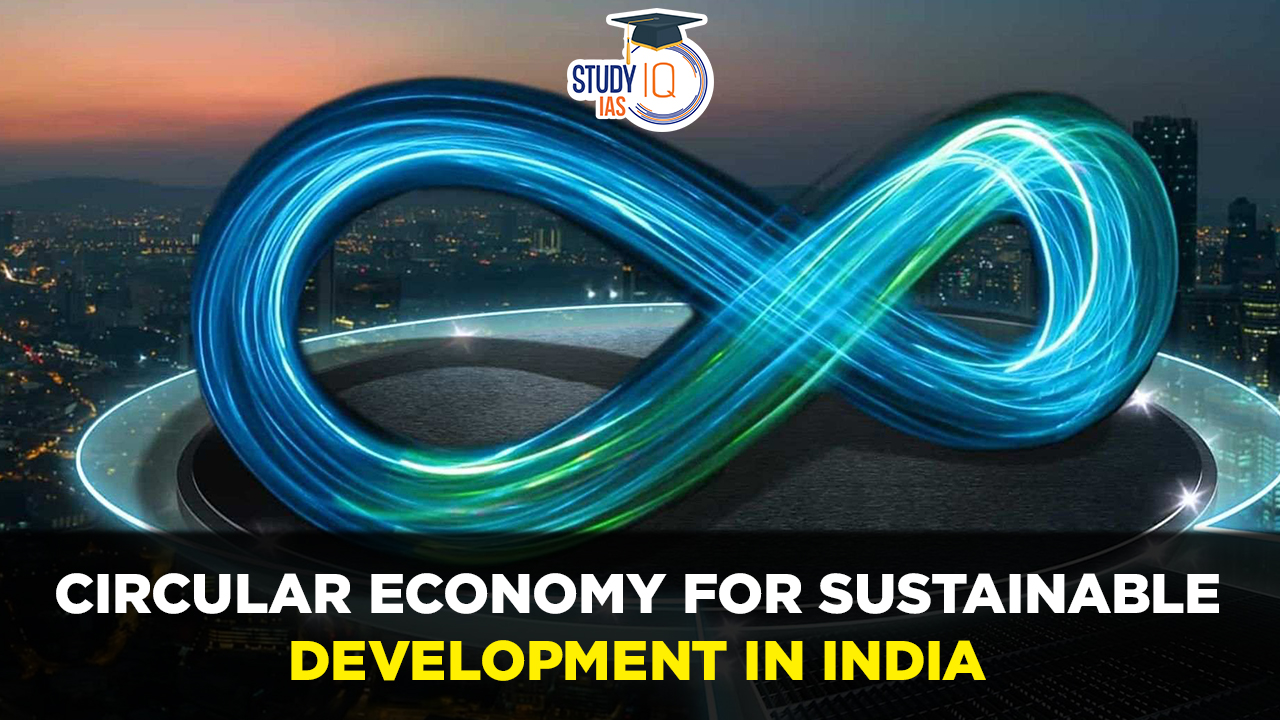Table of Contents
Context: The Union Minister of Environment, Forest, and Climate Change launched the Resource Efficiency Circular Economy Industry Coalition (RECEIC) on the sidelines of the 4th G20 Environment and Climate Sustainability Working Group (ECSWG) meeting held in Chennai.
About the Resource Efficiency Circular Economy Industry Coalition (RECEIC)
- It is a first-of-its-kind initiative aimed at promoting resource efficiency and circular economy practices with participation from 39 global companies.
- The 39 companies are headquartered in 11 countries, including India, and the number is likely to increase in the coming months.
- The Mission: The mission of this coalition is to –
- Facilitate and foster greater company-to-company collaboration,
- Build advanced capabilities across sectors and value chains,
- Bring learnings from diverse and global experiences of the coalition members, and
- Unlock on-ground private sector action to enhance resource efficiency and accelerate circular economy transition.
- Focus Areas: RECEIC will focus on areas such as power, beverages, steel, FMCG, fashion, cement, polymer, electronics, packaging, and automobiles.
- Three Pillars: The coalition is structured around the three guiding pillars of partnerships for impact, technology cooperation and finance for scale.

What is Circular Economy?
- The circular economy is an economic model that aims to minimize waste, maximize resource efficiency, and promote sustainability.
- It is designed to move away from the traditional linear economy, where products are manufactured, used, and then discarded as waste.
- In a circular economy, products, materials, and resources are kept in use for as long as possible, and their value is retained through multiple cycles of use and recycling.
Key Principles of Circular Economy
- Design for longevity and durability: Products are designed to last longer, be easily repairable, and upgradeable to extend their lifespan.
- Reuse and refurbishment: Used products are repaired, refurbished, or remanufactured to be sold again, reducing the need for new products and minimizing waste.
- Recycling and materials recovery: At the end of a product’s life, materials are recovered and recycled to create new products, closing the loop and reducing the demand for virgin resources.
- Waste reduction and resource efficiency: The circular economy aims to reduce waste generation at every stage of the product life cycle and optimize the use of resources.
- Biomimicry: Taking inspiration from nature, the circular economy seeks to develop technologies and systems that mimic natural ecosystems’ regenerative and waste-free characteristics.
Is Recycling the Same as That of The Circular Economy?
- Although the two concepts are interconnected, a circular economy is more comprehensive and ambitious.
- In Recycling, the majority of recyclable goods can only be downcycled, which results in a loss of quality with each subsequent life cycle and eventual waste.
- Without any fresh material inputs, a circular economy would reduce emissions, waste, and ultimately costs.
- A circular economy would educate individuals on their consumption habits in addition to enhancing recycling systems.
Need for Circular Economy Model in India
- Waste management: India generates a massive amount of waste, particularly in urban areas, which is increasing rapidly. Circular economy helps in waste minimization.
- Presently, 377 million people living in urban cities, produce approximately 55 million tonnes of Municipal Solid Waste (MSW) per year, which may go up to 125 million MT by 2031.
- Moreover, only 75-80% of the MSW gets collected; out of which only 22-28% is processed, and the rest is dumped in dump yards, causing severe environmental pollution.
- Resource depletion: As a rapidly developing country, India’s demand for resources is growing. However, traditional linear models of production and consumption are leading to the depletion of natural resources, which is unsustainable in the long run.
- According to the United Nations’ World Population Prospects-2022, India’s population is expected to swell up to 166.8 crores by 2050.
- By 2030, India is expected to be the world’s third-largest economy, accounting for approximately 8.5% of the global GDP.
- Environmental pollution: The linear economy generates a significant amount of pollution, including air, water, and soil pollution, contributing to climate change and various health issues.
- Air pollution: According to IQAir, 21 out of the 30 most polluted cities in the world are in India.
- Plastic Pollution: India alone generates 60% of the world’s plastic waste, of which only 30 per cent is recycled.
- Land degradation: Over 29% (96.4 million hectares) of India’s total geographical area (328.7 million hectares) is going through severe land degradation.
- Water pollution: It is estimated that approximately 70% of India’s surface water is unfit for human consumption, according to the World Economic Forum.
- GHG emissions: Globally, India is the third largest emitter of greenhouse gas after China and the US, emitting around 2.6 billion tonnes CO2 equivalent annually.
- Climate change: India is vulnerable to the impacts of climate change, including extreme weather events, rising sea levels, and changing precipitation patterns. Adopting a circular economy can help reduce greenhouse gas emissions and promote climate resilience.
- According to a report by the London-based global think tank Overseas Development Institute, India may lose anywhere around 3 to 10 per cent of its GDP annually by 2100 and its poverty rate may rise by 3.5 per cent in 2040 due to climate change.
- Economic growth and job creation: A circular economy can spur economic growth by creating new business opportunities, promoting innovation, and generating employment in various sectors, such as recycling, remanufacturing, and sharing platforms.
- Achieving SDGs: The circular economy holds particular promise for achieving multiple SDGs, including SDGs 6 on energy, 8 on economic growth, 11 on sustainable cities, 12 on sustainable consumption and production, 13 on climate change, 14 on oceans, and 15 on life on land.
Government Initiatives to Promote Circular Economy
- E-Waste (Management) Rules, 2016: The rules were notified by the Ministry of Environment, Forest and Climate Change (MoEFCC) to address the growing concerns of electronic waste (e-waste) management in the country.
- These rules are aimed at curbing the improper disposal of electronic products and to promote sustainable practices for e-waste management.
- Plastic Waste Management (Second Amendment) Rules, 2022: The Union Environment Ministry has launched this policy to mandate to increase in the thickness of plastic carry bags to over 120 microns starting on December 31, 2022, and the phase-out of some single-use plastic products starting on July 1, 2022.
- Battery Waste Management Rules, 2022: The rules function based on the concept of Extended Producer Responsibility (EPR) where the producers of batteries are responsible for the collection and recycling/refurbishment of waste batteries and the use of recovered materials from waste into new batteries.
- Swachh Bharat Mission – Urban 2.0 (SBM-U2.0): It aims to achieve the objective of safe sanitation in urban areas by making all cities “Garbage Free,” guaranteeing grey and black water management in all cities besides those covered by Atal Mission for Rejuvenation and Urban Transformation (AMRUT) and making all urban local bodies open defecation free (ODF+).
- In order to effectively manage solid waste, the mission will concentrate on source segregation of trash, using the 3Rs (reduce, reuse, recycle) as a guideline, scientific processing of all sorts of municipal solid waste, and repair of former dumpsites.
Challenges for Circular Economy in India
- Lack of Clear Vision: Despite policy efforts, there is a lack of a clear vision towards the end-goal of India’s circular economy mission. This can lead to confusion and gaps in the actual implementation of circular economy policies and initiatives.
- Reluctance of Industries: Industries may be reluctant to adopt the circular economy model due to various factors, including supply chain limitations, lack of incentives to invest in circular practices, and complexities in recycling and remanufacturing processes.
- Sub-optimal Outcomes: Circular economy efforts in India often focus on the end of value chains, leading to sub-optimal economic and environmental outcomes. To achieve maximum impact, circular practices need to be integrated throughout the entire product life cycle.
- Lack of Awareness and Understanding: Many people in India are not familiar with the concept of a circular economy and its benefits, which can hinder support for implementing circular economy.
- Infrastructure Challenges: India’s current infrastructure may not be well-equipped to support a circular economy.
- Insufficient recycling facilities and waste management systems make it challenging to efficiently recycle and reuse materials.
- Cultural Challenges: There is a cultural resistance to the idea of reusing and recycling products in India making it difficult to change consumer behaviour and shift towards a circular economy.
Way Forward
- Statutory Reforms: Implement legislative mandates that require the use of recycled/secondary raw materials in the production cycle.
- Public-Private Partnerships: Foster collaborations between the government, private sector, and civil society to jointly work towards circular economy goals
- Technology-Driven Recycling: Encourage R&D in waste recycling at the university and school levels to involve the masses in technology enhancement for waste management.
- Awareness and Education: Conduct awareness campaigns to educate the public, businesses, and stakeholders about the benefits of a circular economy.
- Government Procurement: Integrate circular economy criteria into government procurement processes, favoring products and services with a lower environmental impact and a higher potential for reuse and recycling.
Conclusion: India’s evolving market and development potential offer a competitive advantage for a circular economy, leading to sustainable and resilient prosperity. Advancements will boost urban and agricultural economies, promote climate mitigation, ensure food and water security, enhance biodiversity, create jobs, and empower underprivileged communities. To achieve this, a comprehensive roadmap for transitioning to a circular economy is crucial.


 World Population Day 2025, Themes, Histo...
World Population Day 2025, Themes, Histo...
 What are Polycyclic Aromatic Hydrocarbon...
What are Polycyclic Aromatic Hydrocarbon...
 Marlin Fish: Species, Features, Appearan...
Marlin Fish: Species, Features, Appearan...





















